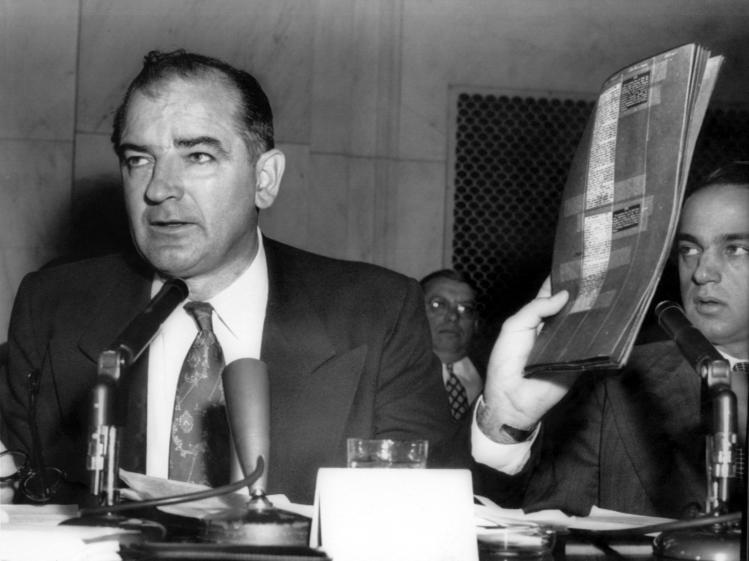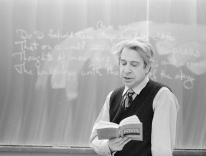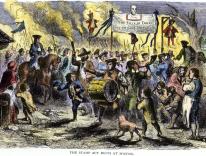
To the extent that Joseph Nye Welch (1890–1960) is remembered today, over sixty years after his death, it is for asking a question. Welch represented the U.S. Army in the “Army-McCarthy Hearings” before the Senate Permanent Subcommittee on Investigations, convened in 1954 to resolve Sen. Joseph McCarthy’s charge that communists had infiltrated the Army and the countercharge against McCarthy that he and his aide Roy Cohn pressured the Army for special privileges for a McCarthy staffer. Tens of millions of Americans tuned into the live, gavel-to-gavel coverage on ABC. While the cameras were rolling on June 9, 1954, McCarthy interjected a non-sequitur by charging a lawyer at Welch’s Boston law firm with having been a member of the left-wing National Lawyers Guild. In response to this charge, Welch addressed McCarthy: “Until this moment, Senator, I think I never really gauged your cruelty or your recklessness.” When McCarthy persisted in the line of questioning, Welch exclaimed: “Let us not assassinate this lad further, Senator. You’ve done enough. Have you no sense of decency, sir? At long last, have you left no sense of decency?”
By late 1954, the Senate had formally condemned McCarthy, and President Eisenhower declared that the movement could be called “McCarthy-wasm.” The problem with naming the Red Scare of the 1950s after McCarthy, however, is that the man’s influence did not end with his fall from power. Christopher M. Elias emphasizes this point in his first book, Gossip Men: J. Edgar Hoover, Joe McCarthy, Roy Cohn, and the Politics of Insinuation, a masterful interpretation of the politics of the early Cold War. Elias describes McCarthyism as “a closet of horrors in which Americans stored their fears of government overreach and expanding federal oversight—once the man had died [in 1957, of cirrhosis], many believed that his tactics would die with him.” They did not, and instead “became folded into the fabric of American political culture.”
To illustrate how pervasive McCarthy’s tactics had become, Elias opens with a different scene from the Army-McCarthy hearings and a different question from Welch. In critiquing a doctored photograph that a McCarthy staffer entered into the record, Welch asked whether the photograph “came from a pixie.” On an objection from McCarthy, Welch belabored the point, describing a pixie as “a close relative of a fairy.” Welch’s innuendo caused “the audience’s light laughter [to be] mixed with guffaws of deeper understanding” that Welch was spreading rumors of homosexuality that hounded both McCarthy and Cohn. In other words, Welch was using their own methods against them.
This exchange, Elias explains, “was only possible because of years of gossip that had circulated either in coded language or through underground channels.” Tracing the genealogy of these methods is at the heart of Gossip Men. During the 1950s, “surveillance state masculinity,” as Elias calls it, arose from the convergence of three developments: the creation of the national-security state; the emergence of gossip as a key element of American politics and society; and the revolution in gender and sexual politics prompted by urbanization. Through the lens of these three dynamics, Elias traces the lives of Gossip Men’s three major figures—McCarthy, Cohn, and FBI Director J. Edgar Hoover—each of whom “rose to power by taking advantage of political anxieties over changing gender roles, communist infiltration, shifting social mores, and perceived increases in criminality.”
Historians typically date the national-security state to the National Security Act of 1947, which, among other things, established the Central Intelligence Agency, the first peacetime non-military intelligence organization. Elias recounts similar information-gathering methods as early as the turn of the century, when American colonial administrators of the Philippines integrated new technologies, including punch cards and telegraphic communications, “to collect, organize, and manage data about possible enemies of the state.” After World War I, Hoover’s meteoric rise within the Justice Department to head the Bureau of Investigation at age twenty-nine can be attributed to the zeal with which he used such techniques to identify, track, and deport political dissidents, including, most famously, the anarchist Emma Goldman during the Red Scare of 1919.
Gossip—which Elias defines as “the public circulation of information that interested parties would prefer remain private”—was also transformed during the first half of the twentieth century into an industry “fueled by the building up and tearing down of reputations and personalities.” Central to this fuel was “a renewed emphasis on the idea that information itself both held power and could be dangerous.” And, just as gossip columnists relied on the whispers of informants to develop their stories, Hoover, McCarthy, and Cohn “placed a significant weight on hearsay” in constructing their dossiers on allies and rivals.
In describing the “masculinity” of the surveillance state, not for nothing does Elias highlight Hoover’s upbringing in a muscular Christianity that “emphasized the role of male virility in mainline Protestantism.” Hoover described his childhood pastor at Washington D.C.’s First Presbyterian Church, Rev. Donald Campbell MacLeod, as “a virile, wide-awake man with a lot of punch” and “the kind of man [he] wanted to be.” Hoover made it his mission to masculinize the FBI’s G-Men, starting with himself: Hoover joined high-stakes police raids to gain public approval. Soon, cultural portrayals of the G-Man, starting during the 1930s war on crime, “created a national image of the Bureau and its agents as professional, trustworthy, measured, analytical, athletic, and macho.” They were “action heroes in suits rather than stuffy federal bureaucrats.”
During the moral panic of the 1950s, Hoover, McCarthy, and Cohn each “conspicuously performed his masculinity, even while being hounded by rumors and insinuations that he was ‘queer’ or a ‘sissy,’ and thus insufficiently manly to guard the country’s moral well-being and ensure its security.” Hoover lauded McCarthy in a more populist flavor of masculinity: “McCarthy is a former Marine. He was an amateur boxer. He’s Irish. Combine those, and you’re going to have a vigorous individual, who is not going to be pushed around.” While McCarthy’s image was rougher around the edges, Cohn “form[ed] alliances with members of the media [and] provid[ed] gossip columnists with information in exchange for positive press coverage about both his professional and personal endeavors.” One such personal endeavor was a conspicuous heterosexuality: “Cohn embraced every opportunity to be photographed on dates with women (in groups or alone) at elite nightlife hotspots such as the Stork Club’s Cub Room”
While Elias connects the surveillance state masculinity with the muscular Christianity of Hoover’s upbringing, one of the book’s few blind spots is that Elias did not explore the relationship between McCarthy’s Catholicism and his anti-communism. In an article coinciding with the publication of his McCarthy biography, Larry Tye observed in America that, although McCarthy “never actively played up his Catholicism for political gain,” his Catholicism “made it easy to equate Catholicism with patriotism with anti-Communism with pro-McCarthyism,” and thus for some Catholics to show “that rather than harboring fealty to Rome and the papacy, American Catholics were true-blue patriots.” Of course, there are limits to establishing too close of a connection: during the height of McCarthy’s power, Catholic support for McCarthy ran only about 8 to 10 percentage points higher than that of the country as a whole. (For this journal’s part, McCarthy charged Commonweal with performing “a great service to the Communist Party.”) Nonetheless, additional perspective on McCarthy’s religion would have illustrated the connection between McCarthy’s populist credentials and surveillance state masculinity. Not for nothing did Tye observe that, “what stuck with McCarthy” during his undergraduate studies at Marquette University “was his church’s opposition to Communism and its Index of Forbidden Texts.”
The national-security state, the gossip industry, and moral panic over gender roles converged in the 1950s into a surveillance state masculinity in which Hoover, McCarthy, and Cohn each were bullies, and, to some extent, victims of their own successes. Elias ends his genealogy, appropriately, with the later career of Cohn, counsellor to a young Donald Trump, whom Elias calls “the ultimate practitioner of surveillance state masculinity in his masculinist persona, his weaponization of proprietary information, and his employment of the tools of gossip.” Hoover, McCarthy, and Cohn may be long dead, but their influence in the politics of insinuation shows no signs of waning.
Gossip Men
J. Edgar Hoover, Joe McCarthy, Roy Cohn, and the Politics of Insinuation
Christopher M. Elias
University of Chicago Press
$35 | 288 pp.
Please email comments to [email protected] and join the conversation on our Facebook page.
Previous Story
Give Them the Facts
Next Story
A Voice Cries Out


